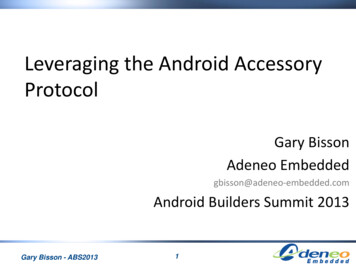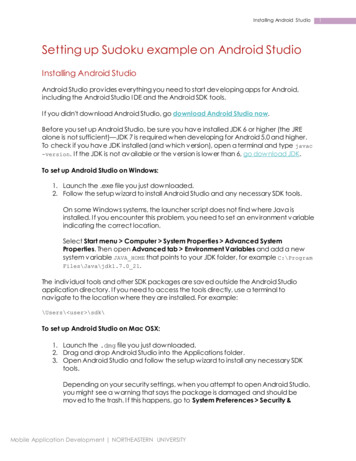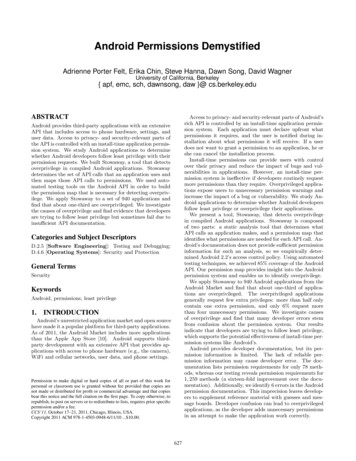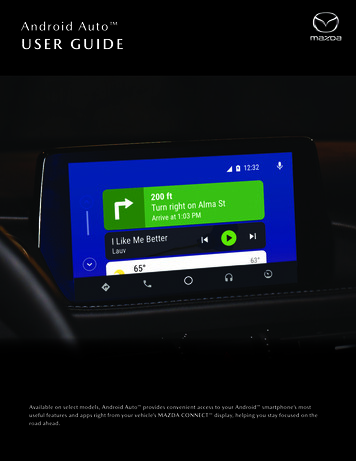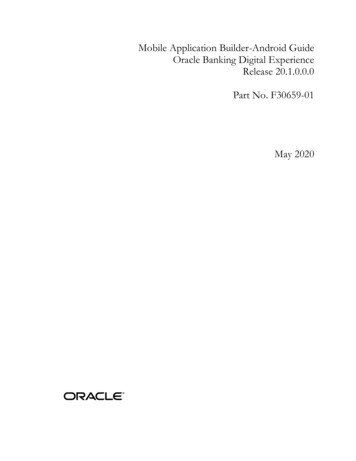
Transcription
AN INTEL COMPANYCommon Android SecurityVulnerabilities in an AutomotiveEnvironmentWHEN IT MATTERS, IT RUNS ON WIND RIVER
COMMON ANDROID SECURITY VULNERABILITIES IN AN AUTOMOTIVE ENVIRONMENTEXECUTIVE SUMMARYSince its first commercial release in 2008, the many security vulnerabilities found in Androidhave made it clear that basic Android Open Source Project (AOSP) Android is not secureenough for deployment in an automotive environment, where it is directly connected in aread/write manner to CAN bus networks that contain safety critical automotive infrastructure. Furthermore, developers for applications running on Android, even those that requirehigh security such as for financial transactions, do not always employ accepted securitypractices. These two factors—Android vulnerabilities and inadequate implementation ofsecurity practices—will cause problems in an automotive environment without adequateprotection.Many of the known vulnerabilities from the cellular area are relevant to the use of Androidin an integrated automotive environment. This paper explores a selected subset of themost relevant of these. The list is not exhaustive, but it provides broad coverage of thetypes of vulnerabilities and exploits that can be expected in an automotive environment—for both attacks and attackers could come in many different forms. Some examples include: Directed broad attacks targeted at applying brakes on only one side of the vehicle inorder to put many vehicles into a spin while driving at highway speeds on congestedfreeways at a specific time Script kiddies driving down the road and causing all the windows of nearby cars toopen and close while in range Attacks against the service center using the automobile as an attack vectorBy first understanding these vulnerabilities, we can then create layers of strategies toprevent them from being exploited.TABLE OF CONTENTSExecutive Summary. . . . . . . . . . . . . . . . . . . . . . . . . . . . . . . . . . . . . . . . . . . . . . . . . . . . . . . . . . . 2Vulnerabilities . . . . . . . . . . . . . . . . . . . . . . . . . . . . . . . . . . . . . . . . . . . . . . . . . . . . . . . . . . . . . . . 3Rootkits and Other System-Level Threats . . . . . . . . . . . . . . . . . . . . . . . . . . . . . . . . . . . . . . 3Denial of Service. . . . . . . . . . . . . . . . . . . . . . . . . . . . . . . . . . . . . . . . . . . . . . . . . . . . . . . . . . . 3Middleware Vulnerabilities. . . . . . . . . . . . . . . . . . . . . . . . . . . . . . . . . . . . . . . . . . . . . . . . . . . 3Image, Video, and Audio Vulnerabilities . . . . . . . . . . . . . . . . . . . . . . . . . . . . . . . . . . . . . . . 4Browser Vulnerabilities . . . . . . . . . . . . . . . . . . . . . . . . . . . . . . . . . . . . . . . . . . . . . . . . . . . . . . 4Application Vulnerabilities . . . . . . . . . . . . . . . . . . . . . . . . . . . . . . . . . . . . . . . . . . . . . . . . . . . 4Viral Aspects of Malware . . . . . . . . . . . . . . . . . . . . . . . . . . . . . . . . . . . . . . . . . . . . . . . . . . . . 5Botnets . . . . . . . . . . . . . . . . . . . . . . . . . . . . . . . . . . . . . . . . . . . . . . . . . . . . . . . . . . . . . . . . . . 5Other Vulnerabilities . . . . . . . . . . . . . . . . . . . . . . . . . . . . . . . . . . . . . . . . . . . . . . . . . . . . . . 5Security Enhancement Strategies . . . . . . . . . . . . . . . . . . . . . . . . . . . . . . . . . . . . . . . . . . . . . . . 5Conclusion. . . . . . . . . . . . . . . . . . . . . . . . . . . . . . . . . . . . . . . . . . . . . . . . . . . . . . . . . . . . . . . . . . 62 White Paper
COMMON ANDROID SECURITY VULNERABILITIES IN AN AUTOMOTIVE ENVIRONMENTVULNERABILITIESoccur so frequently or last for the full 15–20 year lifespan of theThis section examines a subset of the known Android vulnerabili-vehicle. Therefore, automotive systems should incorporate addi-ties. The primary source of this information is the U.S. Nationaltional security capabilities that will continue to protect againstVulnerability Database (NVD). As of September 2013, the NVD listsattack well after the car is no longer able to update to newer ver-more than 300 public entries that match the search “android.”sions of Android that have fixed known vulnerabilities.However, the NVD does have some limitations as a source of infor-Finally, the following classes of vulnerabilities have been selectedmation about Android vulnerabilities. First, other vulnerabilitiesdue to their relevance to automotive uses of Android.exist that are general browser or Linux kernel vulnerabilities whichaffect Android systems, but are not included in that list.Rootkits and Other System-Level ThreatsA very common and often well-advertised type of vulnerabilitySecond, in some ways, the largest threat comes from social engi-allows a user to gain system-level privileges on the system. Onneering attacks, where the user is duped into allowing activitiesstandard phones, this allows operations such as overclocking thethat compromise the system. For example, typical cell phone usersprocessor, abnormal management of SD cards and USB devices,are not aware of the factors that make up a secure system, so theyand other system-level operations that are allowed only to thecan be easily deceived. Social engineering attacks are not tracked“root” user.in the NVD, nor listed prominently in this document. No technicalsolution is relevant, and the educational solutions attempted sofar have had, at best, lackluster results. In an automotive environment, it may be acceptable to limit the choices that a user canOn a cellular device, this may be acceptable or even desirable tousers. But if the device is interconnected with automotive systems,this kind of control cannot be allowed.make in order to prevent successful social engineering attacksDenial of Servicefrom creating safety vulnerabilities.There are many levels of vulnerabilities on Android that can leadThird, not all reported vulnerabilities are exploited, and not allto denial-of-service conditions, ranging from a simple crash of aexploited vulnerabilities are reported. Some vulnerabilities arespecific application to forcing the system into an infinite rebootdiscovered by white hat investigative hackers and then closed,loop that denies any service provided by the entire device.and only after the vulnerability has been closed is it disclosedThe triggers for this kind of attack may be internal to the device,publicly. Other known vulnerabilities have not yet been, and maysuch as a buggy or malicious application that has been installed.never be, reported to the NVD or accepted by their review boardOr they can be completely external to the device, such as specificdue to a lack of reporting requirements and lack of social pressurenetwork traffic patterns visible to the device. In either case, theto report them. Some of those vulnerabilities are undoubtedlyend result is a service or device that is unavailable, which could bealready exploited by malware. In this report, where no Commonannoying and distracting to an automotive customer.Vulnerabilities and Exposures (CVE) number is listed, the vulnerability is a candidate for this category. Also, in some cases the vulnerability is listed and a CVE number is assigned, but the reportwas made by the owning agency, Google in this case, and the CVEdescription is not made public. Vulnerabilities of this nature arenot included in this report.Fourth, many of the reported vulnerabilities are no longer applicable to the most recent versions of Android. They have beenfixed. However, even those vulnerabilities are still open to themany deployed devices running older versions of Android. It isexpected that updates to automotive Android devices will not3 White PaperMiddleware VulnerabilitiesThe overall architecture of Android is as follows: The Linux kernel is used to manage the device hardware, but typical Linux userenvironments have been replaced with custom Android software.This custom Android layer can be referred to as Android middleware. This middleware includes init, the code that starts everythingrunning; bionic, which is a library for applications to use to gainsystem services and functionality; dalvik, a system to run Javacode; daemons such as vold, the system to manage SD cards andUSB devices; and other modules.
COMMON ANDROID SECURITY VULNERABILITIES IN AN AUTOMOTIVE ENVIRONMENTMany of the known vulnerabilities in Android are related to thisAnd for the most part, users are not given the choice to examinemiddleware layer. As a result, automakers who wish to use Androidcode before it is executed.in integrated automotive environments would need either toperform rigorous inspection and certification of the middleware,which would be prohibitively costly, or to use mechanisms externalto Android itself to limit the ability of Android to adversely affectautomotive systems. Failure to take either of those actions wouldrisk leaving vulnerabilities in place that might adversely affectBrowser vulnerabilities are widespread, and the same vulnerabilitycan be present on different browsers and on different operatingsystems with the same browser. So even though the NVD lists 17known Android browser vulnerabilities, it is likely that some otherknown browser vulnerabilities are also relevant to Android.safety critical automotive systems. However, a middle course isOne particularly nasty browser-based attack uses the telephonyalso possible, in which Android security is improved and hardwareUnstructured Supplementary Service Data (USSD) functionality inmechanisms are also used to limit adverse effects of attacks.a denial-of-service attack2. A USSD code can be issued to causeAndroid can be safely integrated with automotive systems—butcare must be taken to ensure that the interfaces restrict the interaction appropriately and prevent adverse effects to safety criticalsystems. For example, it may be necessary to have an interlockbetween the Android device and the driver seat adjustment—aswitch that would only allow the Android system to control seatposition while the button is pressed, giving the driver full controlthe system to perform a factory reset. This operation destroys alluser data, and can keep the device out of service for several minutes while the factory reset is performed. The attack can happenfrom any website, and it is executed without warning to the user.The HTML code to implement this attack is a very simple one-lineHTML statement. This vulnerability is not publicly listed or searchable in the NVD.over disconnecting the Android system from the control loop.Application VulnerabilitiesOtherwise, a malicious Android app could wait for an especiallyDue to poor quality, general Android applications from variousdistracting event such as a freeway entry to move the seat.Android marketplaces should not be made available on any auto-Image, Video, and Audio VulnerabilitiesHundreds of vulnerabilities have been filed against Adobe FlashPlayer, including against the versions used on Android devices.Although some of these bugs have been around for a long time,they have not been fixed in recent releases and are still relevantto today’s devices. There are also vulnerabilities in PDF viewers,JPEG support libraries, and other proprietary data format management tools.In an automotive environment, a crafted audio file burned onto aCD and played by a specific car model’s CD player can be createdso that it inserts user-defined raw CAN bus packets into the invehicle network for that vehicle1.motive system that might have interconnects with other automotive systems unless adequate protections are in place. Applicationdevelopers, as a whole, do not have the experience, background,or willingness to follow best practice guidelines for high-securityapplications necessary to produce secure software. This does notindicate that the in-vehicle Android system should not have accessto an app market, and this paper proposes that as part of a solution. However, general purpose applications, not designed for theautomotive environment, should be avoided.As a result of the lack of background and security-aware practices,many applications contain bugs and vulnerabilities. The NVDshows more than 127 matches to a search for “android application” (as of September, 2013). But this number is a drop in theBrowser Vulnerabilitiesbucket compared to the number of critical reviews availableBrowsers are a special form of middleware, and need to be treateddirectly from Google Play that appear to report bugs.separately. One primary aspect of a browser is that it downloadsWhen standards are enforced, it may be completely acceptable toexecutable HTML code, and possibly other kinds of code, from aallow general developers to create applications for use on an info-remote server and then executes that code. There are no guaran-tainment system3. But in order to accomplish this, strict enforce-tees that the external code is correct, nor that it is not malicious.ment of the application marketplace is required, as well as strict4 White Paper
COMMON ANDROID SECURITY VULNERABILITIES IN AN AUTOMOTIVE ENVIRONMENTenforcement of devices so that they can only install applicationsThe effects on the user can include sluggish system performance,from the secure market, and not from the Web or other unreliabledenial of service when the provider discovers that the device ismarkets.being used in a way that violates the usage agreement, andViral Aspects of Malwarecharges to the account for data or SMS overages.One kind of threat in an automotive environment is the use ofIn addition, botnets are often used to collect and disseminatemalware to attack not just the automobile or driver, but the autopersonal information about the device owner, which is fed backmanufacturer. This might happen in a number of ways. For theinto their database to provide higher returns on spam sent to thatpurposes of this paper, we use the example of a service center’sindividual.computer as the target of the attack.An automotive application that is infested with botnet code wouldIn the security community, directed attacks are considered rare,result in the same effects listed above as for a cellular or tabletbut they are also known to be much more difficult to defenddevice. In a connected automotive infotainment system, theseagainst. Whereas the opportunistic attacker can find a vulnerabil-symptoms would result in a negative impact on the auto manufac-ity and use it wherever it is most convenient, the directed attackerturer’s reputation. In addition, sluggish performance may result infinds information specific to a given target and tries to find vulner-safety issues in cases where Android is integrated with automotiveabilities in it. Thus, the job of the attacker is more difficult, butsystems; for example, when the Android system is used to displaydefending against this kind of attack requires absolute, compre-the backup camera.hensive security.Other VulnerabilitiesUse of an automobile’s computers to attack service centers is aNear field communication (NFC) has been shown to be insecure4.credible scenario, just as is the opposite: attacking an automo-Although the direct attack surface of NFC itself is small, with ative computer via the service center computer. In both variants,few thousand lines of code and very short packets, the integra-the results in an automotive environment would include denial oftion of NFC with other applications means that NFC can be usedservice while the service center’s computer is being investigated,to silently force a system to visit a compromised website or takeunhappy customers when their vehicle service cannot be per-other dangerous action. So the indirect attack surface of NFC isformed at the scheduled time, direct costs associated with find-huge.ing and eradicating the malware, other direct costs that dependon the characteristics of the malware being used, and potentialreduction in the safety of vehicle operation for any vehicle servicedbetween the time the service center’s computer is infected andthe time the infection is detected.With care and security-conscious review of designs and implementations, NFC can be used effectively and securely.SECURITY ENHANCEMENT STRATEGIESAndroid was not developed with high levels of security as a designBotnetsrequirement. Therefore, care must be taken when using AndroidAndroid devices can be compromised by those who want to usein an automotive environment to avoid creating high-risk situa-them for sending spam, phishing attacks, and other money-making schemes. They typically accomplish this by adding a layer toa well-known game or application. The game or app performs itsnormal function, and the malicious layer works in the backgroundto send SMS messages, email, or other types of messages to destinations determined by a remote server.5 White Papertions inadvertently, and avoid opening vulnerabilities that can beexploited by malicious code. Figure 1 shows common guidance forimproving software security. In a separate paper, we will proposeways to alleviate the known Android problems in an automotiveenvironment by following a multi-layer defense-in-depth strategy.
COMMON ANDROID SECURITY VULNERABILITIES IN AN AUTOMOTIVE ENVIRONMENTSupportedProtocolsI/OEnvironmentThreat AssessmentComplete DeviceSecurity AssessmentSecurityOptimized DesignSecureRun-Time SelectionApplicationProtectionDevelopmentLifecycle and ToolsSeparation ofSystemComponentsCertified Run-TimePlatform(Hyperisor and OS)Use of WhitelistingUse of CodeAnalysis ToolsUse of SecurityEnabled utation-AwareApplication BehaviorSecurity TestSuitesWhat-IfVulnerabilityAnalysisFigure 1: Five steps to enhance embedded securityCONCLUSIONBy adding appropriate enhancements, it is possible to create anThe Android operating system is quickly becoming a platform ofenvironment that is sufficiently secure. For best results, a defense-interest for building next-generation in-vehicle infotainment (IVI)in-depth (DiD) strategy provides separation of convenience andsystems. But as Android devices and technologies continue toinfotainment features from safety critical systems using non-evolve, the embedded Android market is facing a greater needprogrammable, hardware-based barriers, plus software enhance-for stronger security capabilities.ments. Software enhancement measures are discussed in moreStandard Android, as released by Google, may be suitable as adetail in a separate white paper from Wind River .starting point for deployment as a stand-alone infotainment system. But when the infotainment system needs to be connected toother automotive components such as driver controls, vehicle status indicators, backup cameras, or environmental controls, basicAOSP Android does not provide the necessary level of protection.Security enhancements must be made to minimize risk and ensuredriver safety.1Koscher et al., 2010. “Experimental Security Analysis of a ModernA u t o m o b i l e . ” w w w. a u t o s e c . o rg / p u b s / c a r s - o a k l a n d 2 0 1 0 . p d fCheckoway et al., 2012. “Comprehensive Experimental Analyses ofAutomotive Attack Surfaces.” www.autosec.org/pubs/cars-usenixsec2011.pdfJ. Hill, January 18, 2013. “Ford AppLink opens floodgates to in-cariOS, Android, and BlackBerry apps.” erry-apps/3Dan Goodin, July 25, 2012. “Android, Nokia smartphone securitytoppled by Near Field Communication hack.” kia-smartphone-hack/4Vince, September 25, 2012. “TouchWiz-specific hack can hard resetGalaxy S III and other Galaxy phones through their web ycombinator.com/item?id 45696862Wind River is a global leader in delivering software for the Internet of Things. The company’s technology is found in more than 2 billion devices, backed by world-class professional services andcustomer support. Wind River delivers the software and expertise that enable the innovation and deployment of safe, secure, and reliable intelligent systems. 2016 Wind River Systems, Inc. The Wind River logo is a trademark of Wind River Systems, Inc., and Wind River and VxWorks are registered trademarks of Wind River Systems, Inc. Rev. 03/2016
practices. These two factors—Android vulnerabilities and inadequate implementation of security practices—will cause problems in an automotive environment without adequate protection. Many of the known vulnerabilities from the cellular area are relevant to the use of Android in an integrated automotive environment.




